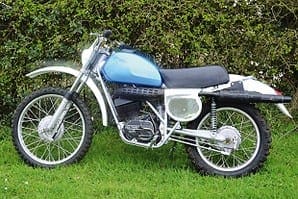
See the step-by-step instructions in the image gallery.
Picture one: Last month I finished off the top end of the engine. Now I'm going to complete the motor before fitting it into the frame. First off, the gear selector mechanism engages into the right hand side of the lower crankcase, the shifter claw hooking around the pins on the end of the selector drum. Note the two detent rollers (left). The large one clicks each gear into place, the smaller roller drops into a notch to locate neutral.
Picture two: The generator rotor and starter clutch assembly fits onto a taper on the left-hand end of the crank, and I can then fit the starter reduction gear. A pin slides through the centre of the gear and engages with the crankcase; note the thrust washers either side of the gear.
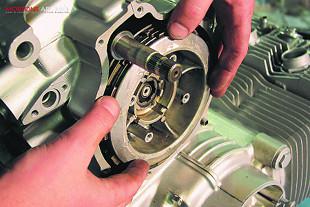 Picture three: On the other side of the engine I'm re-fitting the clutch to the end of the gearbox input shaft. The whole clutch assembly is retained by a bellville washer and special castellated nut, which must be torqued up to 33-36 lb/ft with the same special tool I used to remove it. Finally I can refit the clutch cover to close up the engine.
Picture three: On the other side of the engine I'm re-fitting the clutch to the end of the gearbox input shaft. The whole clutch assembly is retained by a bellville washer and special castellated nut, which must be torqued up to 33-36 lb/ft with the same special tool I used to remove it. Finally I can refit the clutch cover to close up the engine.
Picture four: The next major step will be to get the bike on its wheels. First off, I'm fitting new head bearing races to the frame. A smear of grease around the edges means they should tap in with a copper hammer, though its worth making sure they are engaged squarely before bashing anything too hard.
Picture five: The centre stand fits onto the frame now, using the usual period Honda fitting of a hollow tube pushed through the frame mountings, through the stand itself, and secured with two pinch bolts and nuts. When clamped up the pivot tube should not rotate in the frame lugs, grease it well to make sure the stand doesn't rust on to it later.
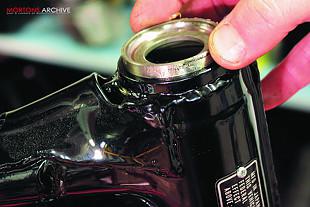 Picture six: Now for the tricky bit, fitting the engine to the frame. I've found it's sometimes easier to put the frame onto the engine, rather than do it the other way round. I've carefully positioned the engine on its right side on the bench and wrapped all the major frame tubes in clean rag before waggling the frame onto the engine. The rags will prevent scratching from inevitable contact as it all gets juggled about. Once the engine is located I can pop the main bolts in, then work around tightening them all up before taking the rags off. Note the pink fluffy blanket on the bench to prevent scratching the engine.
Picture six: Now for the tricky bit, fitting the engine to the frame. I've found it's sometimes easier to put the frame onto the engine, rather than do it the other way round. I've carefully positioned the engine on its right side on the bench and wrapped all the major frame tubes in clean rag before waggling the frame onto the engine. The rags will prevent scratching from inevitable contact as it all gets juggled about. Once the engine is located I can pop the main bolts in, then work around tightening them all up before taking the rags off. Note the pink fluffy blanket on the bench to prevent scratching the engine.
Picture seven: I've left the sump off for the time being, so once upright the whole lot is stable and doesn't wobble around on the sump casting. We carefully stored the original VIN plate before getting the frame powder coated, now it can go back on with a couple of self-tappers.
Picture eight: Fitting the swing arm and shock absorbers is straightforward. I've fitted new bushes (inevitable after bashing the old ones out for powder coating) and greased the pivot bolt before bolting it up. Now the complete rear wheel assembly slots into the fork ends at the rear of the swingarm, which are closed off with the re-plated blanking plugs and new stainless bolts from Inox.
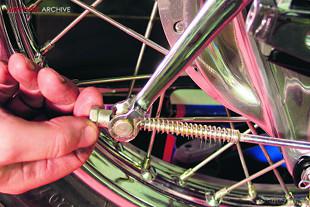 Picture nine: At this stage I've recruited the assistance of an assistant to help me support the front of the bike while we flick the stand down, leaving the whole thing standing on the centre stand and rear wheel. It's pretty stable like this, but I've taken the precaution of hooking a tie-strap round the bike and anchoring it to the workbench to make sure it doesn't tip over while I continue to work on it. Now I'm fitting the rear brake assembly. The wheel is adjusted all the way forward for now, and I'll set up the brake after the chain is fitted and tensioned.
Picture nine: At this stage I've recruited the assistance of an assistant to help me support the front of the bike while we flick the stand down, leaving the whole thing standing on the centre stand and rear wheel. It's pretty stable like this, but I've taken the precaution of hooking a tie-strap round the bike and anchoring it to the workbench to make sure it doesn't tip over while I continue to work on it. Now I'm fitting the rear brake assembly. The wheel is adjusted all the way forward for now, and I'll set up the brake after the chain is fitted and tensioned.
Picture 10: Up at the front end now I've assembled the bottom yoke into the steering head with new ball bearings, and I can then slide the rebuilt fork legs in and fit the top yoke. I don't have the headlamp brackets back from the painter yet, so I'll have to disturb all this later. However I can get the bike on its wheels and get the brakes set up.
Picture 11: The front wheel fits upwards into the bottom of the fork sliders, and is retained by a clamp on each side. There's some assembly to do first, the wheel spindle slides into the bearings from the right and clamps up to them with this long sleeve nut, which has been re-plated to match the wheel spindle. Don't forget the speedo drive!
 Picture 12: Up at the top end, I'm clamping up the handlebars with these lovely polished stainless bolts, again from Inox. At last I have something that looks like a motorcycle again, and if need be I could now take it off the bench and wheel it out of the way. However, I really would like to have a front brake working before dropping it down off the ramp, so there's a bit more to do yet.
Picture 12: Up at the top end, I'm clamping up the handlebars with these lovely polished stainless bolts, again from Inox. At last I have something that looks like a motorcycle again, and if need be I could now take it off the bench and wheel it out of the way. However, I really would like to have a front brake working before dropping it down off the ramp, so there's a bit more to do yet.
Picture 13: First things first, though. Now the bike is on its wheels I can re-fit the oil pump and sump pan to finally close up the motor. The oil pump is located with three M6 bolts. At the front I've fitted a new oil filter and clamped the filter housing up gently to seal at the crankcase. Don't overtighten the centre bolt, as it can be a real problem to unfasten later if its been overdone.
Picture 14: It may seem a bit early in the proceedings, but re-fitting the oil tank now means I can add some oil and crank the engine over a few times on the kickstarter to prime up the lubrication system. The oil tank is the one major component which hasn't been reconditioned. As it’s hidden behind the side panel, I see no point in powder coating it, and the shot blasting which is part of the coating process could leave residual grit in the tank. Three bolts with rubber mountings clamp it to the right side of the frame, and the oil pipes bolt up to the crankcase. These will only fit one way, so it’s not possible to cross up the feed and return sides of the system.
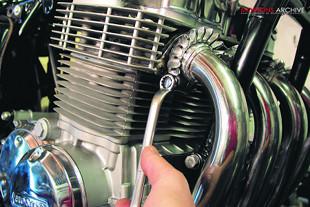 Picture 15: The exhaust pipes were in pretty good nick to begin with, so they're going back on. The early CB750 had four flanges which bolt on to the head ports, the four header pipes then push over the flange stubs and are clamped up with classic style cast rose clamps. I've had these clamps, and various other bits and bobs, re-chromed by Bob Cooper at CRS in Stafford, and the results are splendid. More polished clamp bolts from Inox finish the job.
Picture 15: The exhaust pipes were in pretty good nick to begin with, so they're going back on. The early CB750 had four flanges which bolt on to the head ports, the four header pipes then push over the flange stubs and are clamped up with classic style cast rose clamps. I've had these clamps, and various other bits and bobs, re-chromed by Bob Cooper at CRS in Stafford, and the results are splendid. More polished clamp bolts from Inox finish the job.
Picture 16: At this stage it’s easy to cover a lot of ground quite quickly and the pile of bits on the floor reduces rapidly. Both pairs of footrests are on, the original pillion rests having been re-plated, and I'm temporarily re-fitting the chainguard which I've cleaned up with silicone polish. I'll be using a heavy duty O ring chain to replace the original, but until it arrives I've used the lightweight original to make sure the sprockets are correctly lined up and all the gears are selecting properly.
Picture 17: The still-air box is a very simple affair compared to the intricate constructions which came later in the development of Jap fours. The top half simply bolts up to the frame with two metal brackets and short panhead screws.
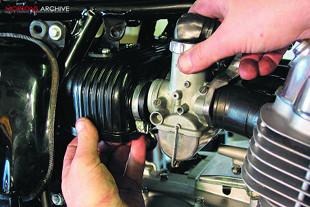 Picture 18: Before clamping it all up it's a doddle to pop the carbs onto their inlet stubs and waggle the four short hoses on the air-box over the carb inlets. Wish it was this easy on later bikes, try doing this on a Z650! The one thing I have learned about re-fitting carbs is that it is always, always easier to fit the throttle cables to the carbs before fitting the carbs to the engine.
Picture 18: Before clamping it all up it's a doddle to pop the carbs onto their inlet stubs and waggle the four short hoses on the air-box over the carb inlets. Wish it was this easy on later bikes, try doing this on a Z650! The one thing I have learned about re-fitting carbs is that it is always, always easier to fit the throttle cables to the carbs before fitting the carbs to the engine.
Picture 19: The air filter element now rests in the lower half of the still-air box, and the whole thing can be offered upwards into place. A glued-in rubber gasket seals the two halves and two wing nuts clamp it up from below. Note the hose clips on the carb rubbers, I've had the originals re-zinc-plated but I'm not quite satisfied with the results. A call to the ever helpful Inox brings a promise of polished stainless clips to replace them, not quite as original but very pleasing to the eye.
Picture 20: There's no putting it off any longer, I'm going to have to get the front brake assembled and working. Triple S have powder coated the caliper body, so now I can fit a new fluid seal and slide the new piston into place.
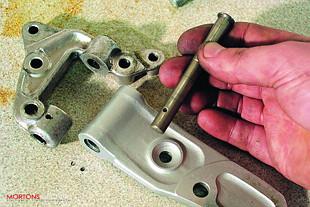 Picture 21: The other problem with the front brake was the swinging pivot, notorious for either seizing up or wearing sloppy. Ours was badly worn, and I'm grateful to engineer Paul Jackson who has bored the holes out to remove ovality, then machined up this one-off stainless pivot pin to replace the original. A superb job, and likely to now last the lifetime of the bike.
Picture 21: The other problem with the front brake was the swinging pivot, notorious for either seizing up or wearing sloppy. Ours was badly worn, and I'm grateful to engineer Paul Jackson who has bored the holes out to remove ovality, then machined up this one-off stainless pivot pin to replace the original. A superb job, and likely to now last the lifetime of the bike.
Picture 22: The swinging caliper mounting bolts to the left-hand fork slider with three M8 bolts, and the two halves of the caliper body can then be assembled around it. Two bolts pass through from the back to hold it all together. Note the bleed nipple, while replacement stainless items are available, this is actually the original item I've had zinc plated.
Picture 23: To maintain the bikes original looks without compromising performance, I'm fitting this braided steel upper brake line from Earls Performance. The hose has a black-plastic coating, which gives it a similar appearance to the rubber original with all the benefits of modern technology. The lower brake hose had already been replaced for a braided item by a previous owner, so I've opted to keep it.
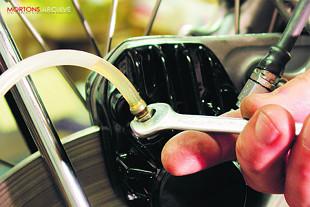 Picture 24: With the brake lines hooked up I can now bleed the front brake. Sometimes this job needs lots of time and patience, but I've always found the old single caliper Honda brakes dead easy to bleed. I've filled the master cylinder and built some pressure in the system with the brake lever, before slackening the bleed nipple on the caliper and allowing any air bubbles to escape. An old battery breather pipe fits perfectly onto the bleed nipple.
Picture 24: With the brake lines hooked up I can now bleed the front brake. Sometimes this job needs lots of time and patience, but I've always found the old single caliper Honda brakes dead easy to bleed. I've filled the master cylinder and built some pressure in the system with the brake lever, before slackening the bleed nipple on the caliper and allowing any air bubbles to escape. An old battery breather pipe fits perfectly onto the bleed nipple.
Picture 25: Last job before knocking off is to fit the oil lines. Unlike older British designs, Honda have swaged alloy fittings onto the ends of the oil pipes. This means they cannot be inadvertently fitted the wrong way round. Each alloy union has an O ring sandwiched between the crankcase to prevent oil leaks. Captive nuts at the top end of the pipes ensure the connections are correct on the oil tank. ![]()




